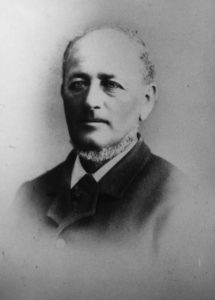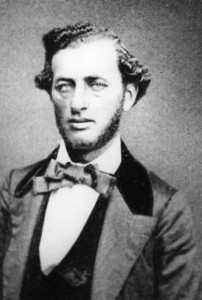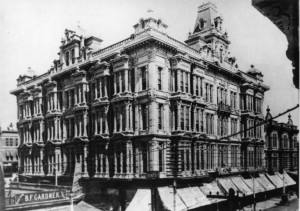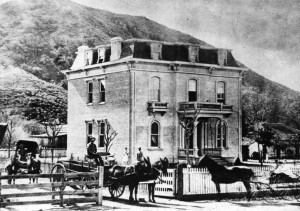Louis Phillips
Values Codes I – E – L – P
“Louis Phillips is well deserving to be held in long, pleasant remembrance as one of the sturdy pioneers who helped fashion and build the great commonwealth of California, and who was especially a leader and controlling factor in Los Angeles and parts of the Southland.”
– Frank Becket, Historian
Louis Phillips was born Louis Galefsky in 1829 at Kempen, Poland, in the Province of Posen, then occupied by Prussia.
When Louis and his brothers, Fitel and Robert, came to the United States in 1848, they changed their surnames to “Phillips.”
After two years in Louisiana, they left for San Francisco via the Panama route.
They opened a store in San Francisco in 1850, but in 1851 Louis Phillips left for Los Angeles.
He became a naturalized citizen in Los Angeles in 1851 (formalized in 1852), making him one of the very first Jews to become a United States citizen in California
Greater Los Angeles
Louis Phillips started his ranching career in 1853.
It is probable that he had some prior experience in Posen.
Phillips purchased a 2,400-acre portion of the San Antonio Ranch along the San Gabriel River.
Today, this land is the site of the cities of Huntington Park, Lynwood, Vernon, Maywood, Bell, South Gate, and Montebello.
On his sizable spread, Louis Phillips engaged in farming and stock raising for the next ten years.
His brother Fitel, who had become a successful merchant in San Francisco, supplied some of his capital needs.
In 1860, Louis purchased another 2,400 acre portion of the San Antonio Ranch.
In 1862, he became owner of the adjacent Rancho San Jose de Abajo, comprising 12,000 acres.
Louis Phillips prospered as a farmer and rancher.
He became close with Harris Newmark and Kaspare Cohn, who often acted as brokers for his wool and grain.
“Any day one might see Phillips riding over the ranch alone, or with his lifelong friend and foreman, Jose Perez, notebook in hand, taking inventory of stock, marking what was his and noting whatever needed attention. His herds increased . . .”
– Judith Shires, historian
“Phillips, in contrast to the original Mexican grantees, never ran into debt and never wasted anything or purchased products he didn’t need.”
– Frank Bracket, Pomona historian
By 1874, Louis Phillips owned and operated a total of 20,000 acres, pasturing 6,000 sheep and 300 head of cattle.
This area comprised most of what we know today as the Pomona Valley.
Phillips sold a portion of this land to developers who created the beginnings of the City of Pomona.
He also owned property within the new city and built a number of downtown buildings there.
During these ten years, Phillips also engaged in real estate in the budding town of Los Angeles, eventually owning a number of city blocks.
On one, known as Phillips Block No. 1., he erected a four-and-a-half story structure in the heart of the retail business district, Los Angeles’ first “skyscraper.”
Hamburger’s Department Store opened its first Los Angeles store under the name of The Peoples Store, and was located in the Phillips’ Building.
Other “Phillips Blocks” contained hotels, restaurants, and assorted business establishments.
In 1892, a Los Angeles Times reporter asked Harris Newmark who he thought was the richest man in Los Angeles County. Newmark replied:
“There is no doubt that the richest property holder in the county today is Louis Phillips, who lives so quietly out in Spadra, near Pomona. He has, for several years, had the largest receipts of any businessman in this part of the state. He is also extremely fortunate in his selection of real estate, and every month adds more to the value of his blocks and buildings.”
– Los Angeles Times, September 18, 1892
Civic
Louis Phillips was one of the founders of Pomona College and acted as a trustee for many years.

Louis Phillips, Pomona,CA, 1829-1900, WS#1667-
Family
Louis Phillips married Esther Blake in 1866.
The had 5 children: Charles, George, Louis Jr., Kate Cele, and Mrs. Frank George.
They settled in a house in an area they called Spadra, which was equal distance between Los Angeles and San Bernardino. A small town developed around this site.
Eventually they built their second empire-style mansion nearby, which has been restored and is on the National Registry of Historic Places.
Louis Phillips died in 1900 in his mansion, shortly after a visit by his friend, Kaspare Cohn.
Unlike many other Jewish pioneers of Los Angeles, Louis Phillips has rarely been covered by Jewish historians.
However, a section of Pomona, built in 1980, is known as the Phillips Ranch.
There is a Phillips Boulevard in Pomona and a number of Phillips Roads, Streets and Avenues in the surrounding towns.
Information from a visitor to this exhibit:
In 1948, my parents bought a home in Westmont, next to the Phillips Ranch in Pomona. Dudley Phillips owned the ranch then. We boarded three horses on the ranch. The ranch foreman then was Jim Sharp who lived in a small house near Mission Blvd., which ran near the edge of the ranch. With Jim was his wife Helen, son Steve and ranch hand Fred Hayes.
— Dan Fenske, July 2013
Source
- Norton B. Stern, “Louis Phillips of the Pomona Valley: Rancher and Real Estate Investor,” Western States Jewish History 16/1.



